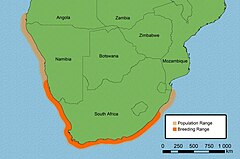African oystercatcher
| African oystercatcher | |
|---|---|
 |
|
| African oystercatcher in Betty's Bay | |
| Scientific classification | |
| Kingdom: | Animalia |
| Phylum: | Chordata |
| Class: | Aves |
| Order: | Charadriiformes |
| Family: | Haematopodidae |
| Genus: | Haematopus |
| Species: | H. moquini |
| Binomial name | |
|
Haematopus moquini (Bonaparte, 1856) |
|
 |
|
| African oystercatcher Population and Breeding Range. Orange = Breeding Range, Pale Orange = Population Range. | |
| Synonyms | |
|
Metanibyx africana ? |
|
Metanibyx africana ?
Haematopus niger Moquin, 1820
Ostralega capensis Lichtenstein, 1823
Haematopus capensis Gray, 1847
Melanibyx moquini Reichenbach, 1851
Haematopus unicolor Lichtenstein, 1854
Melanibyx capensis Heine, 1890
Haematopus ostralegus moquini Peters, 1934
The African oystercatcher or African black oystercatcher (Haematopus moquini), is a large charismatic wader resident to the mainland coasts and offshore islands of southern Africa. This near-threatened oystercatcher has a population of over 6,000 adults, which breed between November and April. The scientific name moquini commemorates the French naturalist Alfred Moquin-Tandon who discovered and named this species before Bonaparte.
The African oystercatcher is a large, noisy wader, with completely black plumage, red legs and a strong broad red bill. The sexes are similar in appearance, however, females are larger and have a slightly longer beak than males. Juveniles have soft grey plumage and do not express the characteristic red legs and beak until after they fledged. The call is a distinctive loud piping, very similar to Eurasian oystercatchers. As the Eurasian oystercatcher is a migratory species they only occur as a vagrant in southern Africa, and its black-and-white plumage makes confusion impossible.
Body Length: 42–45 cm (17–18 in)
Wingspan: 80 and 88 cm (31 and 35 in)
Mass: ♂ 665 g (1.466 lb) ♀ 730 g (1.61 lb)
Tarsus: 50.6 to 60.8 mm (1.99 to 2.39 in)
Culmen: 57.7 to 79.1 cm (22.7 to 31.1 in)
...
Wikipedia

